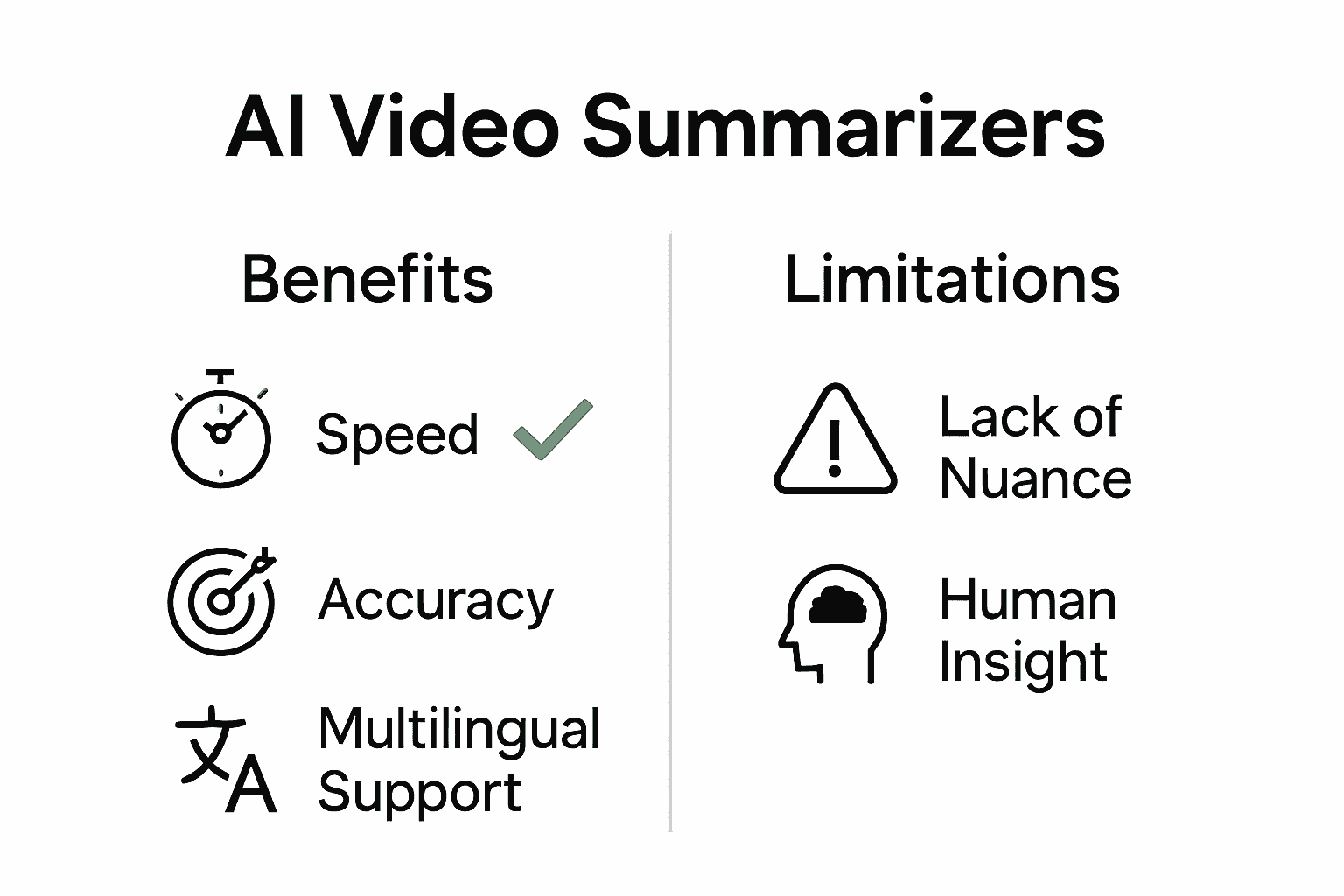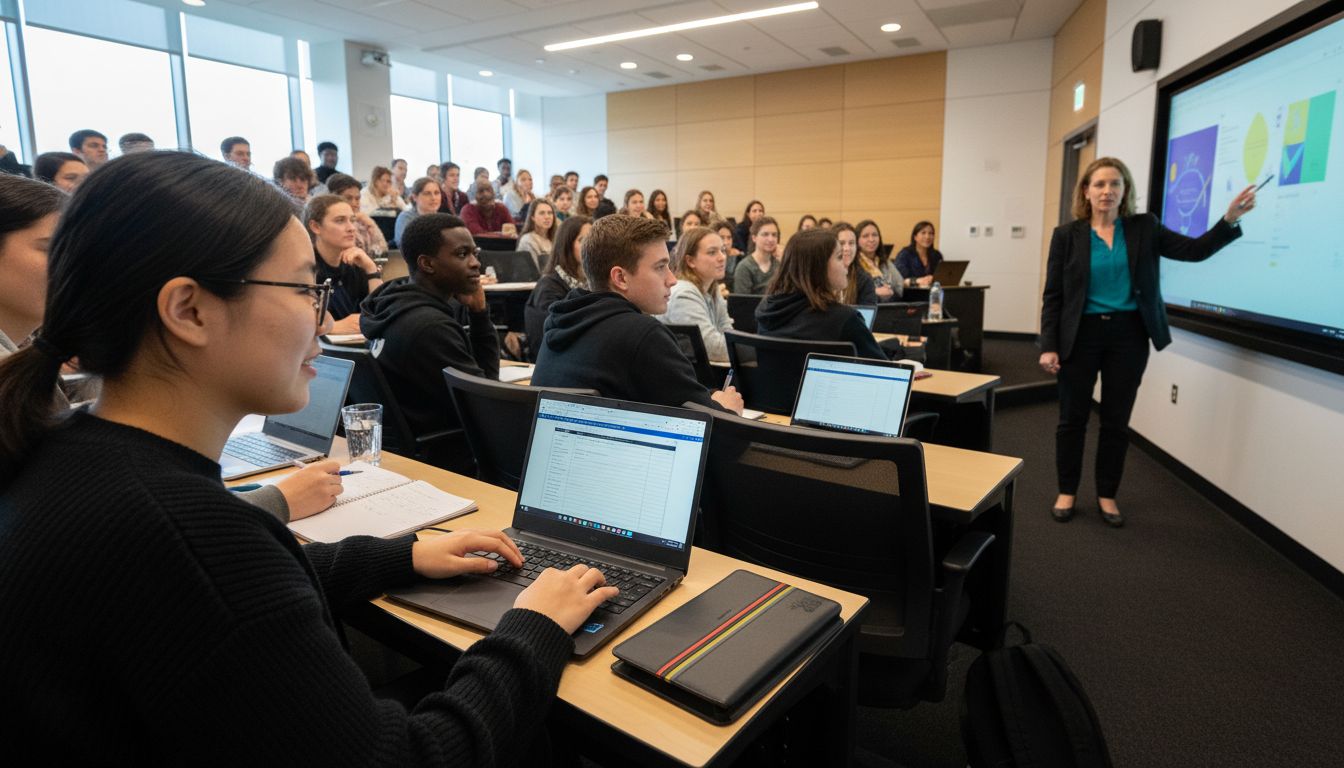Improve Video Comprehension: Complete Guide for 2025

More than 85 percent of american students now rely on video for learning. As classrooms and workplaces shift toward multimedia content, the ability to truly understand and analyze videos becomes a key advantage. Mastering video comprehension goes far beyond watching clips—it empowers people to extract meaning, connect ideas, and learn faster in a world flooded with information. This guide breaks down the most effective ways to turn video viewing from a passive task into an active learning skill.
Table of Contents
- Defining Video Comprehension And Its Importance
- Key Methods For Improving Video Comprehension
- Using AI Summarizers: Benefits And Limitations
- Common Challenges And Mistakes To Avoid
- Practical Strategies For Faster, Deeper Learning
Key Takeaways
| Point | Details |
|---|---|
| Video comprehension is essential | The ability to understand visual information has become a vital cognitive skill in multimedia learning environments. |
| Active engagement strategies enhance learning | Techniques such as note-taking, pausing for reflection, and using playback controls foster deeper comprehension of video content. |
| AI summarizers offer efficiency | These tools can quickly extract key insights from video materials, though they cannot fully replace critical human analysis. |
| Avoid passive consumption | Engaging actively with video content helps prevent information overload and fosters better retention of knowledge. |
Defining Video Comprehension and Its Importance
Video comprehension represents the critical ability to understand, analyze, and extract meaningful insights from video content effectively. As modern learning environments become increasingly multimedia-driven, the skill of processing visual information quickly and accurately has transformed from a nice-to-have ability into an essential cognitive competency.
According to research from the Universitat Oberta de Catalunya, students recognize videos as fundamental yet complementary learning resources that facilitate deeper understanding of complex subjects. The research highlights how video comprehension enables learners to grasp nuanced concepts through dynamic visual presentations that traditional text-based materials cannot always convey.
Key Components of Effective Video Comprehension include:
- Active listening and visual engagement
- Critical analysis of visual and auditory information
- Ability to synthesize complex narratives
- Extracting core messages and key takeaways
- Connecting visual content with existing knowledge frameworks
In academic and professional contexts, strong video comprehension skills provide significant advantages. MDPI research on educational technologies demonstrates that video content can dramatically enhance learning outcomes by creating more engaging and interactive educational experiences. Professionals who master video comprehension can rapidly process information from webinars, training videos, conferences, and digital presentations, dramatically reducing time spent consuming content while maximizing knowledge retention.
By developing strategic approaches to video comprehension, individuals can transform passive viewing into an active, efficient learning process that accelerates understanding across multiple domains.

Key Methods for Improving Video Comprehension
Improving video comprehension requires a strategic approach that transforms passive viewing into an active learning experience. Successful learners develop specific techniques that help them extract maximum value from video content, turning potentially overwhelming information into clear, actionable insights.
According to research from MDPI, student-created video materials in flipped classrooms can significantly enhance learning by promoting active engagement. This suggests that transforming video consumption from passive to interactive is crucial for deeper understanding.
Core Strategies for Enhanced Video Comprehension:
- Take structured notes during video playback
- Pause and reflect on complex segments
- Use playback controls to manage learning pace
- Engage in active recall by summarizing key points
- Implement visual mapping techniques
Research from LV Prod highlights that video learning becomes most effective when learners leverage its inherent flexibility.
This means understanding that comprehension isn’t about watching the entire video in one sitting, but strategically breaking down content into digestible segments.
Additionally, technological tools can dramatically improve video comprehension. Video productivity tips for learning faster can help learners develop systematic approaches to extracting key information efficiently, reducing cognitive load and accelerating knowledge acquisition.
Using AI Summarizers: Benefits and Limitations
AI summarizers have emerged as powerful tools that transform how we consume and understand video content, offering unprecedented efficiency in information processing. These advanced technologies leverage sophisticated algorithms to distill complex video materials into concise, meaningful insights that can dramatically reduce learning and research time.
Research from ArXiv highlights groundbreaking developments in video understanding, specifically the VTimeLLM model which can accurately identify and summarize key events within video content. This technological advancement demonstrates AI’s potential to not just condense information, but to intelligently extract the most critical moments and context from multimedia presentations.
Key Benefits of AI Video Summarizers:
- Rapid extraction of core content
- Elimination of redundant information
- Consistent and objective analysis
- Multilingual comprehension capabilities
- Accessibility for diverse learning styles
According to ArXiv research on Video-LLaMA, AI summarizers are becoming increasingly sophisticated in integrating visual and auditory content, providing comprehensive summaries that capture nuanced details human viewers might miss. Advantages of AI summarizers extend beyond simple time-saving, offering deep insights and structured knowledge extraction.
However, AI summarizers are not without limitations. They can struggle with highly contextual or emotionally nuanced content, sometimes missing subtle interpretive elements that human analysis provides. Users should view these tools as powerful assistants that complement, rather than completely replace, active human engagement and critical thinking.

Common Challenges and Mistakes to Avoid
Video comprehension is a complex skill that requires strategic approach and awareness of potential pitfalls. Learners often encounter significant obstacles that can dramatically reduce their ability to effectively extract and retain information from video content.
Research from ArXiv highlights critical challenges in video understanding, particularly the complexity of managing temporal dependencies in long-form video content. The study reveals that many learners struggle with tracking multiple events and understanding the nuanced progression of information across extended multimedia presentations.
Key Mistakes to Avoid in Video Comprehension:
- Passive watching without active engagement
- Attempting to absorb entire video in one sitting
- Neglecting to take strategic notes
- Ignoring contextual and temporal connections
- Failing to pause and reflect on complex segments
According to ArXiv research, current video learning models often struggle with complex temporal dynamics, a challenge that mirrors individual learners’ experiences. This underscores the importance of developing intentional viewing strategies that go beyond simple observation.
Technological limitations compound these challenges. While AI and advanced learning tools continue to evolve, users must remain critically engaged, recognizing that no summarization tool can completely replace active, thoughtful learning. The most effective approach combines technological assistance with personal cognitive effort, transforming video consumption from a passive to an interactive experience.
Practical Strategies for Faster, Deeper Learning
Learning effectively in the digital age requires more than passive consumption of information. Successful learners develop strategic approaches that transform video content from background noise into actionable knowledge, maximizing comprehension and retention.
According to Wikipedia’s insights on instructional scaffolding, effective learning involves providing structured support systems that guide learners progressively through complex content. This approach breaks down intimidating material into manageable segments, allowing individuals to build understanding systematically.
Key Strategies for Enhanced Learning:
- Create a deliberate viewing environment
- Implement active note-taking techniques
- Use strategic pausing and replay
- Cross-reference multiple learning resources
- Practice immediate knowledge application
- Develop a personal review and reflection process
Multimodal pedagogy research emphasizes incorporating diverse communication modes to accelerate comprehension. This means combining visual, auditory, and textual learning approaches to create a more comprehensive understanding. Video productivity tips for learning faster can help learners develop a multifaceted approach to consuming educational content.
Ultimately, faster and deeper learning is about transforming information consumption into an active, engaged process. By treating video content as an interactive experience rather than a passive stream, learners can dramatically improve their ability to understand, retain, and apply new knowledge across various domains.
Master Video Comprehension Effortlessly with AI Support
The article highlights the struggle of active engagement and strategic note-taking when trying to improve video comprehension. It stresses the challenge of managing complex information over long videos, avoiding passive watching, and synthesizing core ideas quickly. If you have ever felt overwhelmed by lengthy educational videos or wished you could extract only the essential insights without wasting time, you are not alone. The pain points of cognitive overload and time wasted can turn video learning into a frustrating experience rather than an enriching one.

SummYT offers a powerful solution that directly tackles these challenges by providing clear, AI-generated summaries for any YouTube video. Whether you are a student, professional, or lifelong learner, you can save hours by receiving concise key takeaways without watching entire webinars or lectures. With features like unlimited summaries, multilingual support, and one-click browser access, SummYT transforms passive viewing into active, efficient learning. Take control of your video comprehension and boost your productivity today by visiting SummYT and discover how easily you can integrate AI summarization into your study or work routine. Start mastering video comprehension faster and smarter now.
Frequently Asked Questions
How can I improve my video comprehension skills?
Improving video comprehension involves active engagement techniques, such as taking structured notes, pausing to reflect on complex segments, using playback controls to manage your learning pace, and summarizing key points as you go along.
What role do AI summarizers play in enhancing video comprehension?
AI summarizers can rapidly extract core content from videos, eliminating redundancy and providing concise insights. They help temporal tracking of events and capture nuanced details that are crucial for better understanding video material.
What common mistakes should I avoid when watching educational videos?
Common mistakes include passive watching without engagement, trying to absorb the entire video in one sitting, neglecting to take notes, ignoring contextual connections, and failing to pause and reflect on complex information.
What strategies can help me learn faster and deeper from videos?
Effective strategies include creating a focused viewing environment, implementing active note-taking, using strategic pausing and replay methods, cross-referencing multiple resources, applying knowledge immediately, and maintaining a personal review process.




